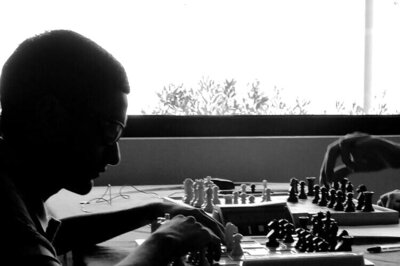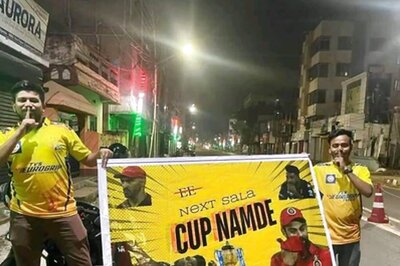
views
Pictures of Rahul Gandhi getting on a truck in front of police barricades near the CBI headquarters and then getting detained at the Lodhi Road police station in New Delhi has a potential of energising the grand old party if the Congress president pitches himself more in uncle Sanjay and grandmother Indira Gandhi's mould. After all, histrionics play a decisive role while tugging at the collective heartstrings of the country.
Way back in May 1979, Rahul Gandhi's uncle Sanjay Gandhi had played a pivotal role in shaping Indira's comeback after the 1977 electoral defeat. On May 2, 1979, The Statesman, Calcutta published on its front page a photograph of a top-half bare Sanjay Gandhi with lathi marks on arms, back and shoulder. Two Congress MPs of that era — M Arunachalam and K Ramalingam — had clearly heard the then Delhi deputy commissioner PS Brar shouting at Sanjay, “I will teach you to become a leader.” A helpless Sanjay could be seen jumping and desperately trying to avoid getting lathi blows on his head. He spent the next two weeks in jail.
While in opposition during 1977-79, Indira and Sanjay repeatedly had to appear as accused before the Shah commission of inquiry. In May 1978, Sanjay was jailed for a month. In 1979, he was jailed six times and spent five weeks in the jails of Delhi, Dehradun and Bareilly. In a criminal case relating to disappearance of the film Kissa Kursi Ka, Sanjay was sentenced to two years. He had to opt for bail and the case slowly slid into obscurity thanks to a series of witnesses turning hostile.
In her pictorial tribute, Sanjay Gandhi, published in 1980, Maneka Gandhi, now a senior minister in the Narendra Modi cabinet, has written that, as a mother, Indira had inculcated a sense of fearlessness in both Sanjay and Rajiv. “One of the qualities she (Indira) inculcated in them was not to be afraid when they felt they were in the right.”
According to her, Sanjay had total disregard for the consequences of what he regarded as a righteous act. “He was not afraid of anything or anyone,” Maneka wrote, elaborating how Sanjay turned his forced imprisonment into enjoyment. “When he was beaten up, he roared with laughter as if it was a college rag.” Sanjay underwent an operation in 1978, but he was asked to appear in court every day. "He could barely stand on his leg but he argued his case himself. To him, everything was an experience. As Kipling put it, he wanted “not to live but to know’.”
After the 1977 defeat, Indira found herself at the receiving end when Delhi Police arrested her in December 1978 when then prime minister Morarji Desai managed to pass a legislation to set up special courts to try Indira and Sanjay Gandhi. Soon after her expulsion and dramatic exit from Parliament, Indira was arrested and taken to Tihar Jail where she was put in the same cell complex that George Fernandes had occupied during the Emergency.
Rahul Gandhi was barely eight years old and may have witnessed some theatrics in public life by his grandmother and uncle. On October 3, 1977 when Sonia Gandhi was preparing the evening tea for her mother-in-law at 12 Willingdon Crescent, CBI superintendent NK Singh knocked on the door. He had come to arrest Indira on charges of misusing her powers when she was Prime Minister.
"Handcuff me!" Indira shrieked at the officer. "I will not go unless I'm handcuffed."
As Sonia watched stoically, brother-in-law Sanjay Gandhi made frantic phone calls to Congress supporters. Using another telephone, Indira’s aide RK Dhawan called the media.
Indira kept delaying her arrest till reporters had arrived in large numbers. "Where is the warrant of arrest and the FIR report?" she asked NK Singh.
When the officer struggled to produce the documents, Indira's lawyer Frank Anthony chipped in: "Is that (Union home minister) Charan Singh's new law?"
"I'll not budge until you handcuff me," Indira insisted. "Bring the handcuffs and take me."
She was eventually taken — without handcuffs — to the officers' mess at the police lines close to the Delhi-Haryana border. The next morning, a magistrate's court in Haryana released her on the technical ground of jurisdiction: the CBI had erred in taking Indira out of Delhi.
The episode prompted Rajiv Gandhi, who was yet to join politics, to comment to French newspaper Le Monde: "Even Mummy herself couldn't have written a better scenario."
"Political prisoners", commented Le Monde, "are often regarded as martyrs in India, where prison, as was once the case for the majority of members of Desai's government, can be an antechamber of power."
Indira was arrested again in December 1978 on the charge of electoral malpractice and spent a week in Tihar jail.
Many in the Congress feel that if the Narendra Modi government tries to "fix" Rahul or Sonia, it will hand the party an opportunity to make political gains.
(The author is visiting fellow at the Observer Research Foundation and a journalist. Views are personal)


















Comments
0 comment